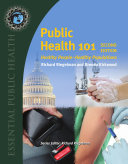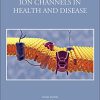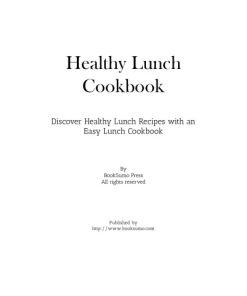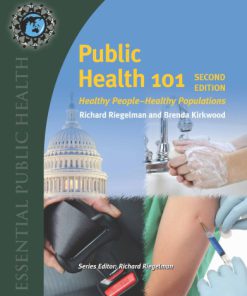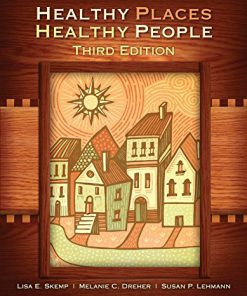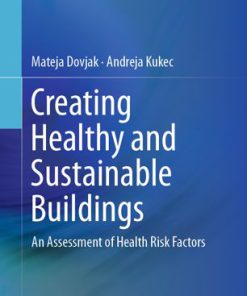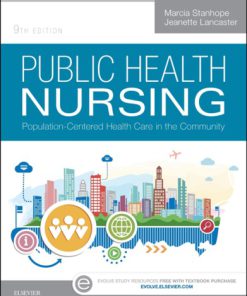Public Health 101 Healthy People Healthy Population 2nd Edition by Richard Riegelman, Brenda Kirkwood 1284066227 9781284066227
$50.00 Original price was: $50.00.$25.00Current price is: $25.00.
Public Health 101 Healthy People Healthy Population 2nd Edition by Richard Riegelman, Brenda Kirkwood – Ebook PDF Instant Download/DeliveryISBN: 1284066227, 9781284066227
Full download Public Health 101 Healthy People Healthy Population 2nd Edition after payment.
Product details:
ISBN-10 : 1284066227
ISBN-13 : 9781284066227
Author: Richard Riegelman, Brenda Kirkwood
Public Health 101 Healthy People Healthy Population 2nd Table of contents:
Section I Principles of Population Health
Chapter 1 Public Health: The Population Health Approach
Learning Objectives
What Do We Mean by “Public Health”?
How Has the Approach of Public Health Changed Over Time?
What Is Meant by “Population Health”?
What Are the Implications of Each of the Four Components of Public Health?
Should We Focus on Everyone or on Vulnerable Groups?
What Are the Approaches Available to Protect and Promote Health?
What Factors Determine the Occurrence of Disease, Disability, and Death?
What Changes in Populations Over Time Can Affect Health?
Key Words
Discussion Question
References
Chapter 2 Evidence-Based Public Health
Learning Objectives
How Can We Describe a Health Problem?
How Can Understanding the Distribution of Disease Help Us Generate Ideas or Hypotheses about the Cause of Disease?
How Do Epidemiologists Investigate Whether There Is Another Explanation for the Difference or Changes in the Distribution of Disease?
What Is the Implication of a Group Association?
Etiology: How Do We Establish Contributory Cause?
What Can We Do if We Cannot Demonstrate All Three Requirements To Definitively Establish Contributory Cause?
What Does Contributory Cause Imply?
Recommendations: What Works To Reduce the Health Impact?
Implementation: How Do We Get the Job Done?
Evaluation: How Do We Evaluate Results?
Key Words
Discussion Questions
References
Section I Cases and Discussion Questions
HIV/AIDS Determinants and Control of the Epidemic
Smoking and Adolescents—The Continuing Problem
Reye’s Syndrome: A Public Health Success Story
Sudden Infant Death Syndrome (SIDS)
Oxygen Use in Premature Infants and Blindness
Section II Tools of Population Health
Chapter 3 Public Health Data and Communications
Learning Objectives
What Is the Scope of Health Communications?
Where Does Public Health Data Come From?
How Is Public Health Information Compiled To Measure the Health of a Population?
How Can We Evaluate the Quality of the Presentation of Health Information?
What Factors Affect How We Perceive Public Health Information?
What Types of Information Needs To Be Combined To Make Health Decisions?
What Other Data Needs To Be Included in Decision Making?
How Do We Utilize Information To Make Health Decisions?
How Can We Use Health Information To Make Healthcare Decisions?
Key Words
Discussion Questions
References
Chapter 4 Social and Behavioral Sciences and Public Health
Learning Objectives
How Is Public Health Related to the Social and Behavioral Sciences?
How Are Social Systems Related to Health?
Complex Interactions
Influencing Behavior
How Do Socioeconomic Status, Culture, and Religion Affect Health?
Socioeconomic Status
Culture
Religion
What Are Social Determinants of Health?
10 Key Categories of Social Determinants of Health
How Do Social Determinants Affect Health?
Can Health Behavior Be Changed?
Why Are Some Individual Health Behaviors Easier To Change than Others?
How Can Individual Behavior Be Changed?
How Can Health Behavior Be Explained and Predicted?
What Are Some Key Theories and Models Used to Address Health Behavior?
Intrapersonal Level
Interpersonal Level
Population and Community Level
How Can Theories Be Applied in Practice?
Choosing a Theory/Model
Planning Frameworks
Key Words
Discussion Questions
References
Chapter 5 Health Law, Policy, and Ethics
Learning Objectives
What Is the Scope of Health Law, Policy, and Ethics?
What Legal Principles Underlie Public Health and Health Care?
What Do We Mean by “Health Policy”?
How Are Public Health Policy Priorities Established?
How Do Philosophies Toward the Role of Government Affect Health Policies?
Is There a Right to Health Care?
How Does Public Health Attempt To Balance the Rights of Individuals and the Needs of Society?
What Bioethical Principles Are Used to Address Public Health Issues?
How Can Bioethical Principles Be Applied to Protecting Individuals Who Participate in Research?
Key Words
Discussion Questions
References
Section II Cases and Discussion Questions
Don’s Diabetes
A New Disease Called SADS—A Decision Analysis
José and Jorge—Identical Twins without Identical Lives
The Obesity Epidemic in the United States—The Tip of an Iceberg
Changing Behavior—Cigarette Smoking
The Elderly Driver
Section III Preventing Disease, Disability, and Death
Chapter 6 Noncommunicable Diseases
Learning Objectives
What Is the Burden of Noncommunicable Disease?
How Can Screening for Disease Address the Burden of Noncommunicable Diseases?
How Can Identification and Treatment of Multiple Risk Factors Be Used To Address the Burden of Noncommunicable Disease?
How Can Cost-Effective Interventions Help Us Address the Burden of Noncommunicable Diseases?
How Can Genetic Counseling and Intervention Be Used To Address the Burden of Chronic Diseases?
What Can We Do When Highly Effective Interventions Do Not Exist?
How Can We Combine Strategies To Address Complex Problems of Noncommunicable Diseases?
Key Words
Discussion Questions
References
Chapter 7 Communicable Diseases
Learning Objectives
What Is the Burden of Disease Caused by Communicable Diseases?
How Do We Establish that an Organism Is a Contributory Cause of a Communicable Disease?
What Factors Affect the Ease with which a Communicable Disease is Transmitted?
Route of Transmission
Asymptomatic Transmission
Reproduction Ratio
What Public Health Tools Are Available To Address the Burden of Communicable Diseases?
How Can Barriers Against Disease Be Used To Address the Burden of Communicable Diseases?
How Can Immunizations Be Used To Address the Burden of Communicable Disease?
How Can Screening and Case Finding Be Used To Address the Burden of Communicable Disease?
How Can Treatment of Those Diagnosed and Their Contacts Help To Address the Burden of Communicable Disease?
How Can Public Health Efforts Maximize Effectiveness of Treatment and Prevent Resistance?
How Can Public Health Strategies Be Used To Eliminate Specific Communicable Diseases?
What Options Are Available for the Control of HIV/AIDS?
What Options Are Available for the Control of Influenza?
What Options Are Available for the Control of Rabies?
Key Words
Discussion Questions
References
Chapter 8 Environmental Health and Safety
Learning Objectives
What Is Meant by “Environment”?
What Is the Burden of Disease Due to the Physical Environment?
How Do We Interact with Our Physical Environment?
How Does Risk Assessment Address the Impacts of the Physical Environment?
What Is a Public Health Assessment?
What Is an Ecological Risk Assessment?
What Is an Interaction Analysis Approach to Environmental Diseases?
What Do We Mean by “Intentional and Unintentional Injuries”?
What Is Being Done To Keep the Population Safe?
Key Words
Discussion Questions
References
Section III Cases and Discussion Questions
High Blood Pressure: A Public Health and Healthcare Success
Testing and Screening
H. pylori and Peptic Ulcers
What to do about Lyme Disease?
Sharma’s Village
Legal Drugs that Kill—Death from Prescription Drug Overdoses
Section IV Health Professionals, Healthcare Institutions, and Healthcare Systems
Chapter 9 Health Professionals and the Health Workforce
Learning Objectives
What Do We Mean by a “Health Professional”?
How Do Education and Training Serve To Define Health Professions?
What Are the Educational Options within Public Health?
What Is the Education and Training Process for Physicians?
What Is the Education and Training Process for Nursing?
What Roles Do Physicians, Nurses, and Other Clinical Health Professions Play in Public Health?
What Is Meant by “Primary, Secondary, and Tertiary Care”?
How Are Clinical Health Professionals Rewarded and Compensated for Their Services?
How Can We Ensure the System has the Right Number of Healthcare Professionals?
Key Words
Discussion Questions
References
Chapter 10 Healthcare Institutions
Learning Objectives
What Institutions Make up the Healthcare System?
What Types of Inpatient Facilities Exist in the United States?
What Types of Outpatient Facilities Exist in the United States?
What Do We Mean by the “Quality of Healthcare Services?”
How Can Health Care Be Coordinated Among the Multiple Institutions that Provide Healthcare Services?
What Types of Coordination of Care Are Needed and What Purposes Do They Serve?
What Types of Healthcare Delivery Systems Are Being Developed and How Can They Help Ensure Coordination of Health Care?
How Can Electronic Medical Records Be Used To Facilitate Coordination of Care and Improve Quality?
How Is Technology Being Used To Improve the Quality of Care?
What Mechanisms Are Being Used To Monitor and Ensure the Quality of Health Care in the United States?
Can Disclosing Medical Errors Contribute to Quality of Care and Serve as an Alternative to Malpractice?
Key Words
Discussion Questions
References
Chapter 11 Health Insurance and Healthcare Systems
Learning Objectives
How Much Money Does the United States Spend on Health Care?
What Types of Government-Supported Health Insurance Are Available?
Medicare
Medicaid
What Types of Employment-Based Health Insurance Are Available?
What Are the Key Health Insurance Changes Incorporated into the ACA Legislation?
What Might the United States Health Insurance System Look Like When the ACA Phase-In Is Completed?
How Can We Describe Healthcare Systems in General and the United States Healthcare System in Particular?
How Can We Describe the Healthcare Systems in Canada and the United Kingdom?
What Conclusions Can We Reach from These Descriptions of the Healthcare Systems in the United States, Canada, and the United Kingdom?
How Can a Healthcare System Be Scored?
Using the National Scorecard, How Does the United States’ Healthcare System Perform Compared to Those of Other Developed Countries?
How Can the Costs of Health Care Be Controlled in the United States?
Key Words
Discussion Questions
References
Section IV Cases and Discussion Questions
When Nursing Meets Medicine
Jack and Continuity of Care
Donna’s Doctor—To Err Is Human
Health Care in the United States—For Better or Worse?
Excess Costs—How Much Can Be Saved?
Section V Public Health Institutions and Systems
Chapter 12 Public Health Institutions and Systems
Learning Objectives
What Are the Goals and Roles of Governmental Public Health Agencies?
What Are the 10 Essential Public Health Services?
What Are the Roles of Local and State Public Health Agencies?
What Are the Roles of Federal Public Health Agencies?
What Are the Roles of Global Health Organizations and Agencies?
How Can Public Health Agencies Work Together?
What Other Government Agencies Are Involved in Health Issues?
What Roles Do Nongovernmental Organizations Play in Public Health?
How Can Public Health Agencies Partner with Health Care To Improve the Response to Health Problems?
How Can Public Health Take the Lead in Mobilizing Community Partnerships To Identify and Solve Health Problems?
Key Words
Discussion Questions
References
Chapter 13 Food and Drugs as Public Health Issues
Learning Objectives
What Are Important Milestones in the History of Food and Drugs as Public Health Issues in the United States?
Food and Food Safety
What Ways Can Food Affect Health and Disease?
How Important Is Foodborne Communicable Disease as a Cause of Morbidity and Mortality?
What Are the Steps in Foodborne Outbreak Investigation?
What Is Being Done To Prevent Foodborne Diseases?
In the United States, What Other Programs Aim to Prevent Food-Related Disease and Disability?
Drugs and Drug Safety
Why Is Drug Safety Considered an Important 21st Century Public Health Issue?
What Do We Mean By “Preclinical Research” on Drugs?
What Is Phase 1?
What Are Phase 2 and Phase 3?
What Are the Implications of FDA Approval of a Drug?
How Are Adverse Effects of a Drug Monitored in Phase 4, after FDA Approval?
What Else Can Be Done?
Do All FDA-Regulated Products Receive the Same Effectiveness and Safety Assessment as Prescription and Nonprescription Drugs?
What Other Products Does the FDA Regulate?
Key Words
Discussion Questions
References
Chapter 14 From Single Solutions to Systems Thinking—The Future of Population Health
Learning Objectives
What Makes Systems Thinking Different?
What Is a System?
How Can Systems Analysis Be Used To Understand the Health Research Process?
What Are the Initial Steps in Systems Analysis?
What Additional Steps Are Needed To Complete a Systems Analysis?
How Can We Use a Systems Analysis To Better Understand a Problem such as Coronary Artery Disease?
How Can We Use Systems Diagrams To Display the Workings of a System?
How Can We Apply Systems Thinking to Population Health Issues?
How Can Systems Thinking Help Us Incorporate Interactions Between Factors To Better Understand the Etiology of Disease?
How Can Systems Thinking Help Take into Account the Interactions Between Diseases?
How Can Systems Thinking Help Us Understand the Impact of a Disease over the Life Span?
How Can Systems Thinking Help Identify Bottlenecks and Leverage Points that Can Be Used To Improve Population Health?
How Can Systems Thinking Help Us Develop Strategies For Multiple Simultaneous Interventions?
How Can Systems Thinking Help Us Look at Processes as a Whole To Plan Short-Term and Long-Term Intervention Strategies?
How Can Systems Thinking Help Us Predict the Future Frequency of Diseases?
What Can Systems Thinking Contribute to Public Health, and What Are Its Limitations?
Key Words
Discussion Questions
References
Section V Cases and Discussion Questions
Public Health Departments—Getting the Lead Out
Community-Oriented Primary Care (COPC)
Hurricane Karl and the Public Health Success in Old Orleans
Lung Cancer: Old Disease, New Approaches
Restorital—How Do We Establish Safety?
The Future of HIV/AIDS
Glossary
Index
ONE HEALTH From AIDS to Zika
Title Page
Copyright
TABLE OF CONTENTS
Where Did the Concept of One Health Originate?
Anthrax
Rabies
Bovine Tuberculosis
Why Is a New Movement Needed?
What Is the One Health Initiative?
I. MICROBIOLOGICAL INFLUENCES ON HEALTH AND DISEASE
What Are the Most Important Microbiological Threats to the Public’s Health?
What Might Be Called the “Top 10” RNA Viruses Causing Emerging Infectious Diseases?
What Is Important to Know About Each of Our Top 10 RNA Viruses?
Acquired Immunodeficiency Syndrome and Human Immunodeficiency Virus
Chikungunya
Dengue
Ebola
Hantavirus
Influenza A
Middle Eastern Respiratory Syndrome
Severe Acute Respiratory Syndrome
West Nile Virus
Zika Virus
II. ECOSYSTEM HEALTH/PHYSICAL ENVIRONMENT
How Can Global Movements of Populations Affect Health?
How Can Agricultural Practices and Changes in Food Distribution Influence the Occurrence of Infectious Diseases in Humans?
How Can Ecological Changes in Land and Resource Use Affect the Development of Infectious Diseases?
How Can Misuse of Technologies Affect the Ecosystem and Human Health?
How Can Climate Change Affect Human Health?
Exacerbated Ozone Health Impacts
Increased Health Impacts from Wildfires
Worsened Allergy and Asthma Conditions
Changing Distributions of Vectors and Vector-Borne Diseases
Earlier Tick Activity and Northward Range Expansion
Changing Mosquito-Borne Disease Dynamics
Emergence of New Vector-Borne Pathogens
III. HUMAN–ANIMAL INTERACTIONS
What Is the Human–Animal Bond and What Are Its Health Benefits?
What Are the Major Risks from Cats and Dogs and How Can They Be Minimized?
What Is Meant by Exotic Pets and What Risks Do They Pose for Infectious Disease?
One Health: Putting It into Practice
What Can Be Done to Prevent and Control the Epidemic and Pandemic Spread of Human Communicable Diseases?
What Can Be Done to Respond to the Threat of Pandemic Diseases?
People also search for Public Health 101 Healthy People Healthy Population 2nd :
toronto public health
remote public health jobs
public health jobs
ottawa public health
american public health association
Tags: Public Health, Healthy People, Healthy Population, Richard Riegelman, Brenda Kirkwood
You may also like…
Cookbooks
Healthy Recipes: A Healthy Cookbook with Delicious and Healthy Recipes 2nd Edition Booksumo Press
Cookbooks
Delicious Bowls: Delicious Recipes for Healthy and Hearty Meals (2nd Edition) Booksumo Press
Uncategorized
Creating Healthy and Sustainable Buildings An Assessment of Health Risk Factors Mateja Dovjak


